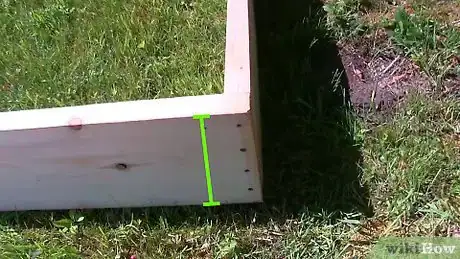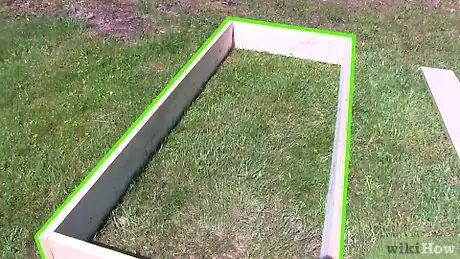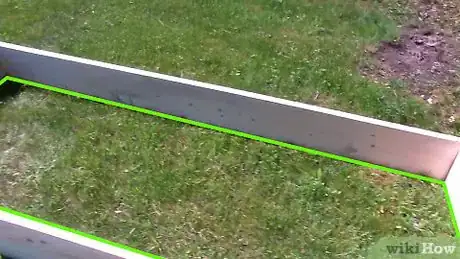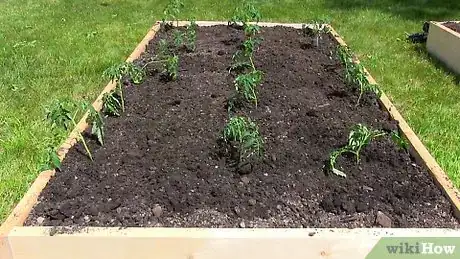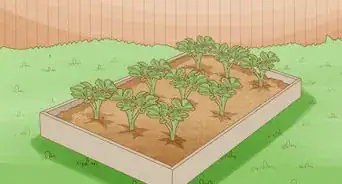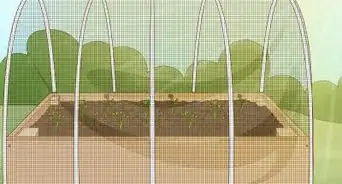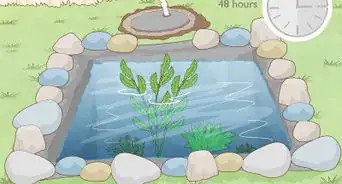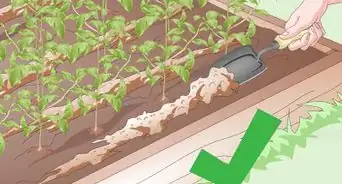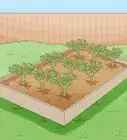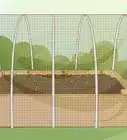X
wikiHow is a “wiki,” similar to Wikipedia, which means that many of our articles are co-written by multiple authors. To create this article, 12 people, some anonymous, worked to edit and improve it over time.
There are 8 references cited in this article, which can be found at the bottom of the page.
This article has been viewed 52,453 times.
Learn more...
Preparing a raised garden bed is similar to preparing an in ground bed. The difference is that the former is set up above the ground. Although you rarely have to dig the ground out before setting up the bed, the groundwork is still time consuming. If you are interested in learning how to prepare a raised garden bed, consider the following steps.
Steps
-
1Draw out a plan of your raised garden. Label where you want each vegetable and flower to grow. Remember to add room for you to maneuver around your garden for harvesting and picking if your garden is for vegetables.[1]
-
2Choose a location for your raised garden bed. Ideally, you should select a place that sits in the sun at least 6 hours in a day.[2]
- For maximum vegetation wellness and also performance, a lot of veggies must obtain at the very least 8 hrs of total sunlight per day, so it is actually ideal to find your brand new yard in an available website that isn't outshined through plants, limited establishments, or even structures. Landscapers in cooler environments are going to take advantage of a portion of the yard remaining in a suntrap, as an example versus a wall structure that experiences the lunchtime sunshine. This may make perfect shapes for tender plants like tomatoes and also wall-trained fruit trees. Situate your yard in the sunniest component of your lawn. Steer clear of reduced, damp locations where the dirt could possibly keep sodden. You'll really want to possess pretty simple accessibility to a tube since your landscape will certainly need to have to be actually irrigated during the course of the developing time.
- Find a perfect location and then remove grass or perennial weeds from the area. Make use of a backyard fork or shovel to loosen up the indigenous soil, estimated depth of 6-10". It likewise indicates that also along with a 5"-higher brought up the garden, your plants will certainly believe they are actually expanding in a bed that is actually 12-18" deep-- lots of space for carrots, whites potato, full-size tomato vegetation, and other veggies you will grow. If you perform certainly do not possess accessibility to premium topsoil, an appropriate alternative will be actually a 50-50 mixture of soilless growing medium (typically contacted "potting soil") as well as compost. If you would like to put peat moss into your raised bed, the amount should not be more than 20 percent of the total mix. This is because peat moss is naturally acidic, which is not a good medium for growing vegetables.
- Great soil is well-drained while keeping sufficient soil humidity for stable growth. Each water-retentive massive clay-based soil and also free-draining soft sand grounds may be strengthened along with liberal add-ons of raw material including well-rotted backyard compost, which enhances the soil's capacity to keep soil steady, plant-friendly humidity amounts.
- Do not fail to remember that added water is going to possibly be actually important in the course of dry out time frames, specifically in the summer season, therefore internet site your brand new mattress effortlessly close to an outside water resource or even a water gun barrel.
Advertisement -
3Decide on the height of your raised bed. If you cannot till your current land, then the plants or flowers you grow will have to depend on the soil in your garden bed. Therefore, expect to build a raised bed that is approximately 3 feet (0.91 m) high. If your land is conducive to planting, then you only need to build a raised bed that is 8 inches (20.32 cm) high.[3]
-
4Decide on the size of your garden and lay out the perimeter. If you choose to use corner posts, lay out a hose or string to define the boundaries of your garden. Position your corner posts and dig a trench approximately 1 to 2 inches (2.54 to 5.08 cm) deep from post to post along the marked edges. Alternatively, for a more simple design, omit the corner posts and lay out your two side walls and front/end boards so that they form a rectangle.[4]
-
5Assemble your garden bed frame. Secure each side wall by screwing it together with the neighboring front or end board. The front and end boards can be placed either inside or outside of the side walls but be sure to be consistent on both ends.[5]
- Support good airflow. Putting your raised garden bed on an open position will certainly absorb much sunshine, however, it’s vital that the plot isn't excessively subjected to dominating winds or even disturbance. Sound wall surfaces or even fencings provide shelter however may likewise create the wind to form harmful swirls on the leeward edge as it is actually required up and also over the barricade, so it is actually certainly not an excellent concept to grow your plants too much close to them. Excellent airflow by means of your yard is necessary to urge strong development in your plants. It will certainly help keep fungus at bay, as well as make your garden landscape much less enticing to some insect bugs including whitefly that favor a still, sweltering atmosphere.
- Hedges, open or woven fences, and other semi-permeable choices are actually suitable as they filter wind instead of dispersing it. You may constantly put together short-term displays while you expect dodging to create.Hedges, open or woven fences, and other semi-permeable alternatives are ideal as they filter wind rather than turn aside from it. You can always set up temporary screens while you wait for hedging to establish.
-
6Use good soil. Good soil is a very important ingredient for a beautiful raised garden bed. Compare to wooden and other brick raised beds. They’re more durable, long-lasting, corrosion-resistant, and environment-friendly. When you fill your raised bed, you can fill it with a blend of soil, which will be better than native soil in your yard. Soil that is actually abundant as well as loosened along with nutrients, as well as raw material, will certainly make it possible for the origins of your vegetations to increase easily, as well as make certain that they possess accessibility to the water as well as nutrients they need to have to maintain well-balanced development.
-
7Level the frame. Dig and add soil where necessary to level the frame. Make sure that the frame is securely in place since it will be keeping your soil and growing plants or flowers from eroding.[6]
-
8Get the base of your raised bed cleaned up before adding the topsoil. If you have Bermuda grass, you will have to remove it with a shovel; otherwise, just get rid of the big weeds, rocks and other debris. Pour the topsoil into the frame. You can also mix in some compost for added nutrition, should you feel it necessary. Just make sure that your soil, whether it's amended or not, feeds your plants and retains some moisture while providing drainage and ventilation. Additionally, you should mix the compost into the topsoil before pouring it into the frame. Once the soil is added, spread it out and rake it down.[7]
-
9Design an irrigating system for your raised vegetable or flower garden. Consider drip irrigation that waters the area. A sprinkle system with perforated hoses is also adequate. Whatever you decide, make sure that your system will not overwater your garden or waste water.[8]
Advertisement
Community Q&A
-
QuestionWe are the last house at the bottom of a steep hill. Our yard is always wet. How do I prepare wet soil before using raised beds?
 Dathan MittonCommunity AnswerOne of the best things about raised beds is that they put you in control of your soil conditions. If you have a lot of rainfall in your area, you may want to make your beds a bit deeper, and add a layer of a couple inches of sand (or even gravel) under your new soil and compost.
Dathan MittonCommunity AnswerOne of the best things about raised beds is that they put you in control of your soil conditions. If you have a lot of rainfall in your area, you may want to make your beds a bit deeper, and add a layer of a couple inches of sand (or even gravel) under your new soil and compost. -
QuestionIs it necessary to add lime and granular fertilizer to a raised flower bed?
 DonaganTop AnswererAdd lime to an acidic soil (low pH). Most plants like a pH balance between 5.5 and 6.5. Fertilizer is always a good idea (in any form except uncomposted manure).
DonaganTop AnswererAdd lime to an acidic soil (low pH). Most plants like a pH balance between 5.5 and 6.5. Fertilizer is always a good idea (in any form except uncomposted manure). -
QuestionDo you have to kill the lawn before laying soil for raised bed?
 Community AnswerTechnically, you do not have to kill the lawn as the grass will naturally die over time. However, removing it fist would make it easier to set up the garden bed.
Community AnswerTechnically, you do not have to kill the lawn as the grass will naturally die over time. However, removing it fist would make it easier to set up the garden bed.
Advertisement
References
- ↑ https://www.gardendesign.com/vegetables/raised-beds.html
- ↑ https://www.growveg.com/guides/whats-the-best-position-for-your-vegetable-garden/
- ↑ https://extension.uga.edu/publications/detail.html?number=C1027-4&title=Raised%20Garden%20Bed%20Dimensions
- ↑ https://www.gardenista.com/posts/hardscaping-101-raised-garden-bed-how-to/
- ↑ https://www.almanac.com/content/how-build-raised-garden-bed
- ↑ https://www.thisoldhouse.com/how-to/how-to-build-raised-vegetable-garden
- ↑ https://www.thisoldhouse.com/how-to/how-to-build-raised-vegetable-garden
- ↑ https://www.popularmechanics.com/home/lawn-garden/how-to/g92/build-raised-garden-beds/
- Videos provided by MIgardener | Simple Organic Gardening & Sustainable Living
About This Article
Advertisement


